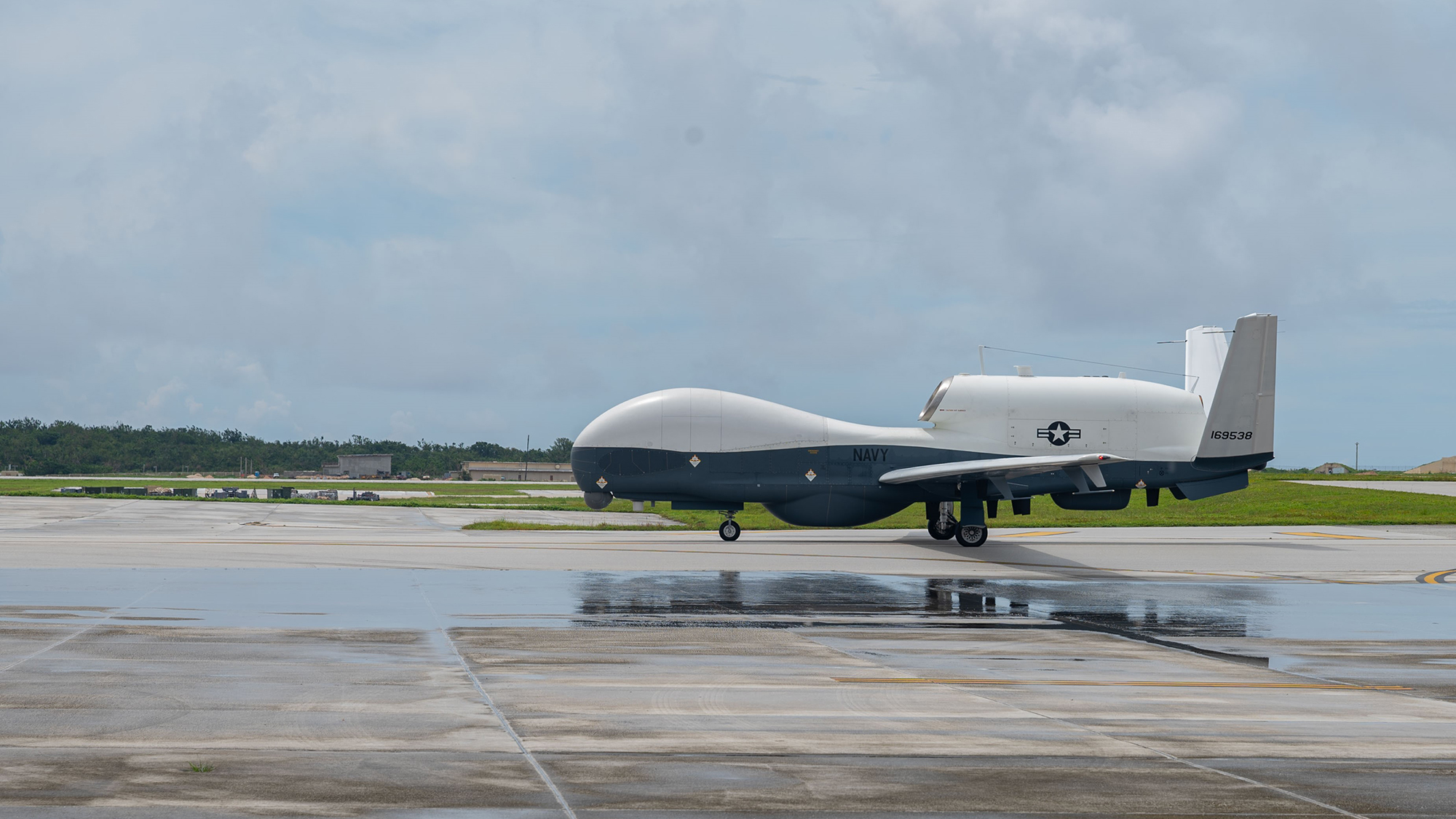

A white-hulled MQ-4C Triton accelerated down a runway in Guam before lifting off into dark clouds. The video, captured August 18 by the US Navy, was recorded to mark a modest milestone in the drone program. The Navy’s Tritons have now reached “initial operating capability,” meaning that enough aircraft, spare parts, and crew are available to use the vehicles as intended. The Triton, the Navy’s version of the RQ-4 Global Hawk flown by the Air Force since 2001, is an eye in the sky, tasked with watching the ocean.
Located over 3,700 miles west from Pearl Harbor in Hawaii and just over 1,800 miles east from the coast of China, Guam is a centerpiece literally and figuratively in the plans and ability of the United States to operate in the Pacific Ocean. The Triton is a flying sensor platform, built for long endurance and maritime domain awareness, or watching and tracking action on the sea below. The Navy’s P-8 Poseidon, a crewed maritime surveillance plane based on the Boeing 737 airline airframe, flies with a nine-person team on board. Being able to have drones perform some of this type of observation, with fresh human crews on the ground swapping out multiple times mid-flight, means that the Navy can maintain surveillance for an extended time.
It takes a team of five to operate the Triton. That means someone to manage the drone’s flight, two people to manage its different sets of sensors, one person in charge of the signals it sends and collects, and a coordinator in charge of the whole operation. The Triton has a wingspan of 130 feet, meaning that its wings stretch wider than those on a 737. It flies at a cruising cruising speed of about 368 mph.
[Related: The US military’s tiniest drone feels like it flew straight out of a sci-fi film]
“We have been successfully operating Triton in Guam for several years, and now we have expanded this platform’s capabilities far beyond those it started with,” said Josh Guerre, MQ-4C Triton program manager, in a release.
Two Tritons were first deployed to Guam, as part of the Navy’s Unmanned Patrol Squad 19 (shortened to VUP-19), in January 2020 through October 2022. That time allowed for significant observations to be made in how the drones operated, and meant that when the Navy redeployed them this summer to Guam, the drones’ sensors had received a major upgrade.
Those sensors are likely the signals intelligence (SIGINT) sensor upgrades boasted about earlier by Triton maker Northrop Grumman: “Triton Multi-INT gets its name from the addition of two new SIGINT sensors: one that gathers electronic intelligence and one that gathers communications intelligence. We’ve also removed an older electronic support measures sensor and installed a new, more capable version of the electro-optical infrared sensor flying on Triton today, said Rob Zmarzlak, chief engineer for Northrop Grumman’s Autonomous ISR and Targeting Programs, in a release.
One of the distinct challenges of watching for activity on the ocean, as compared to scanning for action on the ground, is that the vast and largely uniform expanse of the sea can be especially devoid of human activity, outside of major sea lanes. By listening for the signals given off from boats and ships, the Triton can more reliably find useful activity onto which it can train its cameras.
Northrop Grumman boasts that the Triton can, from an altitude of 50,000 feet and on a mission lasting 24 hours, survey four million nautical miles. That’s a major delivery on the promise of the Triton, which first flew in 2013. As Popular Science said at the time, its high altitude flights will allow it to take in “a 2,000-nautical-mile view of the ocean in every direction” and then “it will be able to tell a container ship from a Chinese frigate from a surfacing Russian submarine–from up to 2,000 nautical miles away (we felt that point was worth stressing here). Triton’s strengthened airframe, augmented with de-icing technology, will then allow it to rapidly descend and ascend, so it can swoop in for a closer look at vessels of particular interest.”
Even as the Navy prepares for Tritons to become a regular part of operations, USNI News reports that the Navy is looking to halt the production of Tritons at just 27 total units, down from the original plan of 70. The Triton is useful for extensive watching of the sea, especially in conjunction with other tools, but it comes with a serious price tag. For 2022, the unit cost of each Triton was roughly $141 million. Even as the US Navy scales down the number of Tritons it is looking to buy and maintain, Australia is looking to expand the number of Tritons it will use and operate from three to four.
Watch the Triton’s ascent in Guam below:

